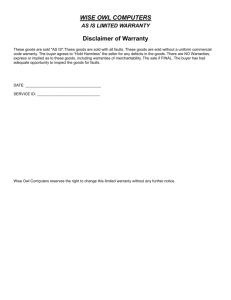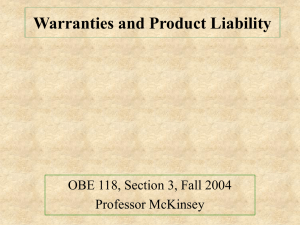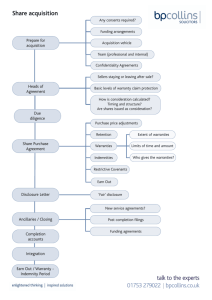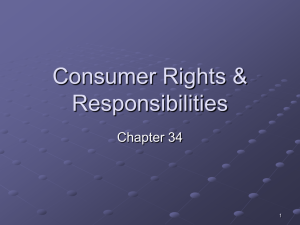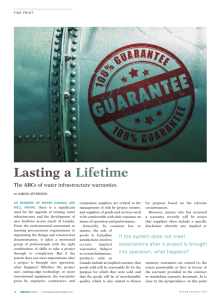Anderson's Business Law 20e
advertisement
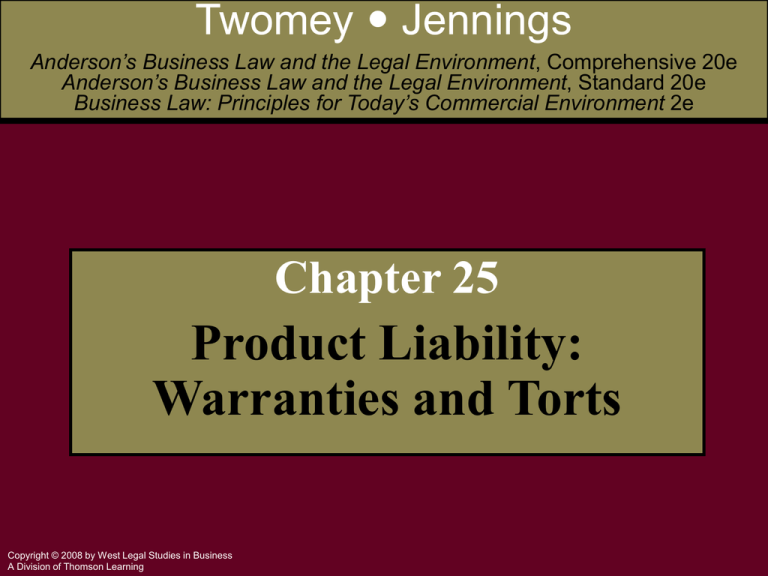
Twomey Jennings Anderson’s Business Law and the Legal Environment, Comprehensive 20e Anderson’s Business Law and the Legal Environment, Standard 20e Business Law: Principles for Today’s Commercial Environment 2e Chapter 25 Product Liability: Warranties and Torts Copyright © 2008 by West Legal Studies in Business A Division of Thomson Learning General Principles: Theories of Liability • There are five theories to protect parties from loss caused by nonconforming goods. They are: – (1) express warranty, – (2) implied warranty, – (3) negligence, – (4) fraud, and – (5) strict tort liability. Copyright © 2008 by West Legal Studies in Business A Division of Thomson Learning 2 General Principles: Theories of Liability • Theories of product liability are not mutually exclusive. A given set of facts may give rise to liability under two or more theories. Copyright © 2008 by West Legal Studies in Business A Division of Thomson Learning 3 Who is Liable in Product Liability? • The idea of privity of contract (only the parties to the contract have warranty protection) has been widely rejected. • The law usually allows any person harmed by an improper product to sue anyone who is in any way responsible. – The buyer, user and even bystanders may become plaintiffs in an action. – The seller, manufacturer, or distributor may become defendants in such actions. 4 Copyright © 2008 by West Legal Studies in Business A Division of Thomson Learning Warranties • Warranties may be express or implied. – Both have the same effect and operate as though the defendant had made an express guarantee. • A warranty made after a sale does not require consideration; it is regarded as a modification of the sales contract. Copyright © 2008 by West Legal Studies in Business A Division of Thomson Learning 5 Express Warranties • Express warranties are regulated by federal statute and the FTC. • These warranties must be labeled as full or limited warranties and must conform to certain standards. • Seller’s Opinion or Statement of Value. Copyright © 2008 by West Legal Studies in Business A Division of Thomson Learning 6 Express Warranties • A distinction is made between a merchant seller and a casual seller. – A merchant seller is responsible for a greater range of warranties. • Magnuson-Moss Warranty Act and Federal Trade Commission enforce warranties. Copyright © 2008 by West Legal Studies in Business A Division of Thomson Learning 7 Implied Warranties • A seller makes a warranty of title (that the seller actually owns the item) unless such warranty is excluded. • A warranty against encumbrances assures the buyer that the item does not have a lien against it. • Warranty of fitness for a particular purpose is enforceable if the seller knew of the buyer’s intended use. Copyright © 2008 by West Legal Studies in Business A Division of Thomson Learning 8 Implied Warranties of Merchant-Seller • Unless otherwise agreed, merchant sellers warrant that the goods are free of patent, copyright or trademark infringement. • A merchant seller warrants that the goods are fit for their normal use (warranty of merchantability). • Particular Sales: – Sale on Buyer’s Specifications. – Sale of Used Goods. – Sale of Food or Drink. Copyright © 2008 by West Legal Studies in Business A Division of Thomson Learning 9 Disclaimer of Warranties • Warranties may be disclaimed by agreement provided the disclaimer is not unconscionable. • To disclaim the implied warranty of merchantability, the term merchantability or language like “as is,” must be used. • Post-sale disclaimers have no effect on warranties that arose at the time of the sale. Copyright © 2008 by West Legal Studies in Business A Division of Thomson Learning 10 Other Theories of Product Liability • Negligence • Fraud • Strict Tort Liability – Without regard to whether injured party is purchaser or bystander. • Theories are not Cumulative Copyright © 2008 by West Legal Studies in Business A Division of Thomson Learning 11 Negligence and Fraud • If an injured person can show that the defendant was negligent in the manufacture or design of a product, he may prevail in an action. • Negligence also includes the failure to provide adequate instructions for use or safety warnings. Copyright © 2008 by West Legal Studies in Business A Division of Thomson Learning 12 Negligence and Fraud • A person defrauded by a manufacturer or distributor’s false statements about a product can generally recover damages sustained because of the misrepresentations. Copyright © 2008 by West Legal Studies in Business A Division of Thomson Learning 13 Strict Tort Liability • A manufacturer or distributor of a defective product is liable to anyone injured by the product – buyer, user, innocent bystander. • The plaintiff must show there was a defect in the product at the time it left the control of the defendant. Copyright © 2008 by West Legal Studies in Business A Division of Thomson Learning 14 Strict Tort Liability • No negligence need be established on the part of the defendant, nor is the plaintiff’s contributory negligence a defense. • The defendant may show that the injured party assumed a known risk. Copyright © 2008 by West Legal Studies in Business A Division of Thomson Learning 15 Cumulative Theories When goods are defective and cause harm or loss, the person harmed has a claim for product liability. Guarantee Strict Tort Liability Negligence Not Mutually Exclusive Implied Warranty Fraud Express Warranty Copyright © 2008 by West Legal Studies in Business A Division of Thomson Learning 16 Warranties Name of Warranty Creation Express Affirmation of fact or promise of performance (includes samples, models, descriptions) Implied Warranty of Merchantability Given in every sale of goods by a merchant (“fit for ordinary purposes”) Implied Warranty of Fitness for a Particular Purpose Seller knows of buyer’s reliance for a particular use (buyer is ignorant) Title Given in every sale Magnuson-Moss (Federal Consumer Product Warranty Law) Only consumer product of $15 or more Copyright © 2008 by West Legal Studies in Business A Division of Thomson Learning Disclaimer Restriction Must be part of the basis of the margin Only given by merchants Cannot make a disclaimer inconsistent with an express warranty (1) Must use “merchantability” or general disclaimer of “as is” or “with all faults” (2) If written, be conspicuous Seller must have Knowledge; Buyer must rely (1) Must be in writing (2) Must be conspicuous (3) Also disclaimed with “as is” or “with all faults” Does not apply when apparent warranty is not given Must say “There is no warranty of title” Must label “Full” or “Limited” None 17
